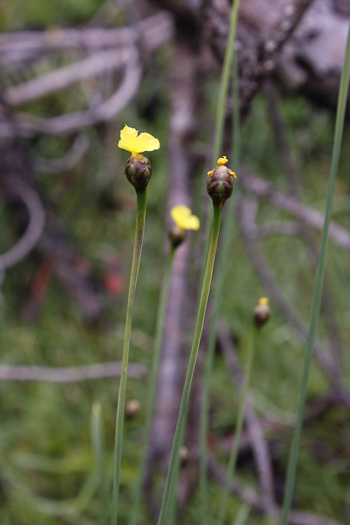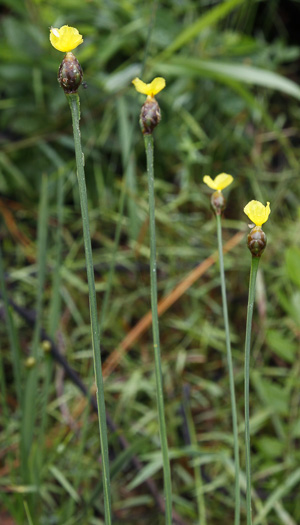Spermatophytes (seed plants): Angiosperms (flowering plants): Monocots: Commelinids: Poales
WEAKLEY'S FLORA OF THE SOUTHEASTERN US (4/14/23):
Xyris scabrifolia
FAMILY
Xyridaceae
Go to FSUS key
Dig deeper at SERNEC, a consortium of southeastern herbaria.
Learn more about Xyris from the Vascular Plants of North Carolina.
This taxon is abundantly distinct from X. chapmanii, through its presence of outer scale leaves and bulbous bases and by having strongly papillose-scabrid leaves, per Weakley's Flora (2023).
INCLUDED WITHIN
PLANTS NATIONAL DATABASE:
Xyris scabrifolia
FAMILY
Xyridaceae
SYNONYMOUS WITH Floristic Synthesis of North America. BONAP (Kartesz, 2021)
Xyris scabrifolia
INCLUDED WITHIN Flora of North America north of Mexico, vol. 22 (2000)
Xyris scabrifolia
INCLUDED WITHIN Floristic Synthesis of North America (Kartesz, 1999)
Xyris scabrifolia
SYNONYMOUS WITH Aquatic & Wetland Plants of Southeastern US (Godfrey & Wooten, 1979 & 1981)
Xyris scabrifolia
SYNONYMOUS WITH Manual of the Southeastern Flora (Small, 1933, 1938)
Xyris scabrifolia
COMMON NAME:
Roughleaf Yellow-eyed-grass, Scabrous-leaved Xyris, Harper's Yellow-eyed-grass
To see larger pictures, click or hover over the thumbnails.
Bruce A. Sorrie bas_xyris_scabrifolia1
July Moore County NC
Flowers grow from a conelike head at top of stem, opening midday or later, per Wildflowers of the Sandhills Region (Sorrie, 2011).
Bruce A. Sorrie bas_xyris_scabrifolia2
July Moore County NC
Stems mostly 10-32", mostly twisted, densely minutely bumpy, glaucescent, per Wildflowers of the Sandhills Region (Sorrie, 2011).
WEAKLEY'S FLORA OF THE SOUTHEASTERN US (4/14/23):
Xyris scabrifolia
FAMILY
Xyridaceae
INCLUDED WITHIN
PLANTS NATIONAL DATABASE:
Xyris scabrifolia
FAMILY
Xyridaceae
SYNONYMOUS WITH
Floristic Synthesis of North America. BONAP (Kartesz, 2021)
Xyris scabrifolia
INCLUDED WITHIN
Flora of North America north of Mexico, vol. 22
Xyris scabrifolia
INCLUDED WITHIN
Floristic Synthesis of North America (Kartesz, 1999)
Xyris scabrifolia
SYNONYMOUS WITH
Aquatic & Wetland Plants of Southeastern US (Godfrey & Wooten, 1979 & 1981)
Xyris scabrifolia
SYNONYMOUS WITH
Manual of the Southeastern Flora (Small, 1933, 1938)
Xyris scabrifolia
If a search such as "Carex leptalea var. leptalea" doesn't deliver the results you want, try "Carex leptalea".
Or, to minimize chances of a misspelling, try just "Carex le".
Less is more: If "pencil flower" doesn't deliver the results you want, try "pencil".



